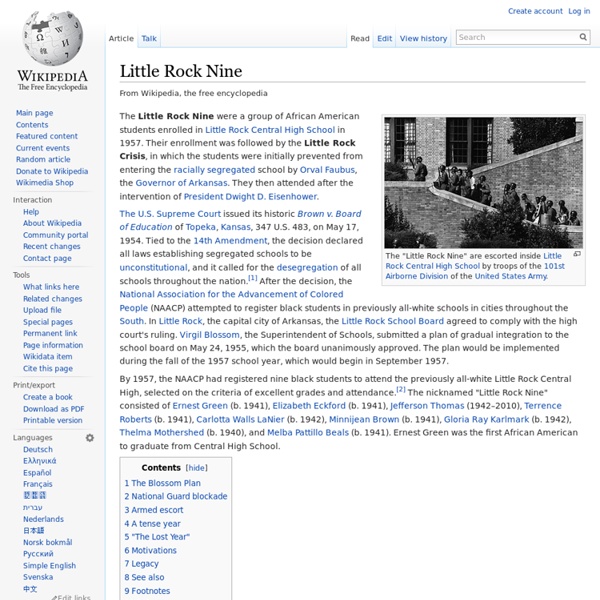3 Facts About The Little Rock Nine
Little Rock Central High 40th Anniversary - The 1957-58 School Year
The 1957-58 school year at Little Rock Central High School should be looked at in terms of what happened in Arkansas prior to it, during it and immediately afterwards. The following timeline presents a brief glimpse into the key events. September, 1949 University of Arkansas School of Law is integrated. January, 1951 Little Rock Public Library board approves integrating its facilities. May 17, 1954 The U.S. Supreme Court rules racial segregation in the public schools is unconstitutional in Brown V. May 22, 1954 The Little Rock School Board issues a policy statement saying it will comply with the Supreme Court's decision when the Court outlines the method to be followed and the time to be allowed. May 24, 1955 The School Board votes unanimously to adopt Superintendent Virgil Blossom's plan of gradual integration that would start in September, 1957, at the high school level and add the lower grades over the next six years. August 28, 1956 Federal Judge John E. August 25, 1958 The U.S.
The Blossom Plan
Little Rock Nine
The Little Rock Nine were the nine African-American students involved in the desegregation of Little Rock Central High School. Their entrance into the school in 1957 sparked a nationwide crisis when Arkansas governor Orval Faubus, in defiance of a federal court order, called out the Arkansas National Guard to prevent the Nine from entering. President Dwight D. Eisenhower responded by federalizing the National Guard and sending in units of the U.S. Army’s 101st Airborne Division to escort the Nine into the school on September 25, 1957. The military presence remained for the duration of the school year. Before transferring to Central, the Nine attended segregated schools for black students in Little Rock (Pulaski County). On May 24, 1955, the Little Rock School Board adopted a plan for gradual integration, known as the Blossom Plan (also known as the Little Rock Phase Program). The Nine remained at home for more than two weeks, trying to keep up with their schoolwork as best they could.
Back-Up
Brown v. Board of Education - History of the Little Rock Nine
Central High In September of 1957, the country was changed forever by the “Crisis at Central High”—one of the first federally ordered integration acts. At that time, the United States was a nation of racial inequalities and segregation. When nine courageous black students dared to challenge racial segregation in public schools by enrolling at the all-white Central High School, the “Little Rock Nine” became an integral part of the fight for equal opportunity in America. History of the Little Rock Nine & Brown v. In 1954, the Supreme Court's Brown v. In September of 1957, the public school ruling was tested for the first time when the “Little Rock Nine” enrolled at Little Rock’s previously all-white Central High School. The list below details the sequence of events before, during and after the desegregation attempt. September 4 - Nine black students, known as the “Little Rock Nine” attempt to enter Central High but are turned away by the National Guard. September 24 - U.S. Visitor's Center
The Little Rock Nine
Ernest Green In 1958, he became the first black student to graduate from Central High School. He graduated from Michigan State University and served as Assistant Secretary of Housing and Urban Affairs under President Jimmy Carter. He currently is a managing partner and vice president of Lehman Brothers in Washington, D.C. Elizabeth Eckford The only one of the nine still living in Little Rock, Elizabeth made a career of the U.S. Jefferson Thomas He graduated from Central in 1960, following a year in which Little Rock's public high schools were ordered closed by the legislature to prevent desegregation. Dr. Following the historic year at Central, his family moved to Los Angeles where he completed high school. Carlotta Walls Lanier One of only three of the nine who eventually graduated from Central, she and Jefferson Thomas returned for their senior year in 1959. Minnijean Brown Trickey Gloria Ray Karlmark Thelma Mothershed-Wair She graduated from college, then made a career of teaching.
Little Rock Nine Picture
Reunited!
The Little Rock Nine Will Always Be Remembered!
The Little Rock Nine Picture
Little Rock Nine: The Problem
The Little Rock Nine: Hope
Little Rock Nine: Action




mhmhmhmmhmhmhmmhmmh
mmhmhmhmhmhmmhmhmhmhmhmhmmhmhmhmhmhmh by zoria100 Mar 21
i didn't mean to. I didn't know what I was doing. by carlicagardner13 Mar 21
the pearl you took it from my pearl tree by zoria100 Mar 21
the little rock nine was a group of african american kids that had been going to segregated schools all their lives. When segregated schools were deemed unconstitutional, and that african american students were permitted to go to school with white children, their hard journey began. These nine kids enrolled in former all white schools, and they were horrased and threateded throughout their whole high school careers. by mariclaregatter Mar 15